

Renaissance Art. Italian Culture: Facts, Customs & Traditions. Italian culture is steeped in the arts, family, architecture, music and food.
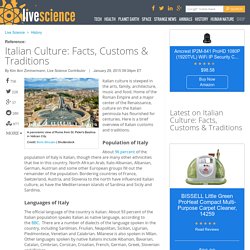
Home of the Roman Empire and a major center of the Renaissance, culture on the Italian peninsula has flourished for centuries. Here is a brief overview of Italian customs and traditions. About 96 percent of the population of Italy is Italian, though there are many other ethnicities that live in this country. Ethnic Identity. Ethnic and Cultural Identity I.
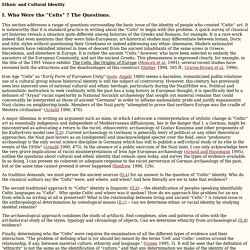
Who Were the "Celts" ? The Questions. This section addresses a range of questions surrounding the basic issue of the identity of people who created "Celtic" art. It is noteworthy that it is standard practice in writing about the "Celts" to begin with this problem. Iron Age "Celts" as "Early Form of European Unity" (note; Angeli 1980) seems a harmless, romanticized public-relations use of a cultural group whose historical identity is still the subject of controversy. A major dilemma in writing an argument such as mine, in which I advocate a reinterpretation of stylistic change in "Celtic" art as essentially indigenous and independent of Mediterranean diffusionism, lies in the danger that I, a German, might be misconstrued as advocating a return to the racist, ethnocentric archaeology of Gustav Kossinna and other proponents of his Kulturkreis model (see II.b).
A. The earliest Greek source, Herodotos (fifth century BCE), mentions a people he calls "Keltoi" History: Famous Renaissance People for Kids. History >> Renaissance for Kids There were many people who had influence and became famous during the Renaissance times.
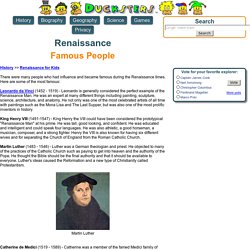
Here are some of the most famous: Leonardo da Vinci (1452 - 1519) - Leonardo is generally considered the perfect example of the Renaissance Man. He was an expert at many different things including painting, sculpture, science, architecture, and anatomy. He not only was one of the most celebrated artists of all time with paintings such as the Mona Lisa and The Last Supper, but was also one of the most prolific inventors in history. King Henry VIII (1491-1547) - King Henry the VIII could have been considered the prototypical "Renaissance Man" at his prime. Martin Luther (1483 - 1546) - Luther was a German theologian and priest. Martin Luther Catherine de Medici (1519 - 1589) - Catherine was a member of the famed Medici family of Florence.
Erasmus (1466 - 1536) - Erasmus was a Dutch priest and scholar. Erasmus. Renaissance Literature - Literature Periods & Movements. Literature Network » Literary Periods » Renaissance Literature The Renaissance in Europe was in one sense an awakening from the long slumber of the Dark Ages.
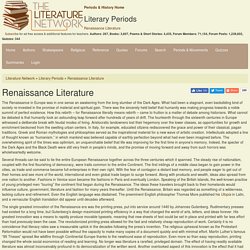
What had been a stagnant, even backsliding kind of society re-invested in the promise of material and spiritual gain. There was the sincerely held belief that humanity was making progress towards a noble summit of perfect existence. How this rebirth – for Renaissance literally means rebirth – came to fruition is a matter of debate among historians. What cannot be debated is that humanity took an astounding leap forward after hundreds of years of drift.
Several threads can be said to tie the entire European Renaissance together across the three centuries which it spanned. The single greatest innovation of the Renaissance era was the printing press, put into service around 1440 by Johannes Gutenberg. Every nation in Western Europe experienced its own incarnation of the Renaissance. This article is copyrighted © 2011 by Jalic Inc. The Influence of the Renaissance on Modern American Society, Culture and Art. Terms & themes. Modernism is not identical to modernity or modernization, though these terms' meanings overlap.
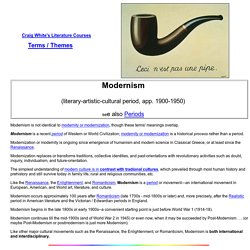
Modernism is a recent period of Western or World Civilization; modernity or modernization is a historical process rather than a period. Modernization or modernity is ongoing since emergence of humanism and modern science in Classical Greece, or at least since the Renaissance. Modernization replaces or transforms traditions, collective identities, and past-orientations with revolutionary activities such as doubt, inquiry, individualism, and future-orientation. The simplest understanding of modern culture is in contrast with tradional cultures, which prevailed through most human history and prehistory and still survive today in family life, rural and religious communities, etc. English Poetry - Renaissance and Reformation. Introduction The English Renaissance, the age of William Shakespeare, Christopher Marlowe, Sir Philip Sidney, Ben Jonson, John Donne, and John Milton, was one of the most brilliant periods in Western literary history for the production of great poetry.
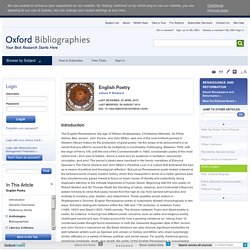
Yet the scope of its achievement is so varied that any effort to account for its multiplicity is inordinately challenging. THE RENAISSANCE - Renaissance Poetry, Renaissance Drama and Prose, Shakespeare, Late Renaissance and 17th Century referat. A golden age of English literature commenced in 1485 and lasted until 1660.
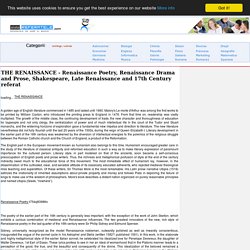
Malory's Le morte d'Arthur was among the first works to be printed by William Caxton, who introduced the printing press to England in 1476. From that time on, readership was vastly multiplied. The growth of the middle class, the continuing development of trade, the new character and thoroughness of education for laypeople and not only clergy, the centralization of power and of much intellectual life in the court of the Tudor and Stuart monarchs, and the widening horizons of exploration gave a fundamental new impetus and direction to literature.
Renaissance/Reformation Literature.